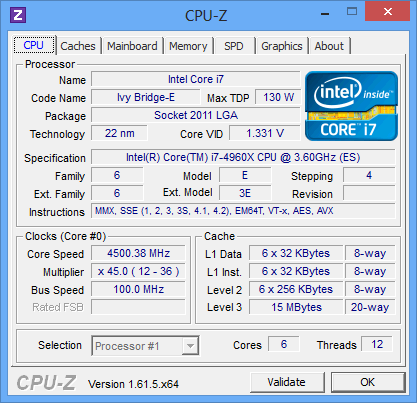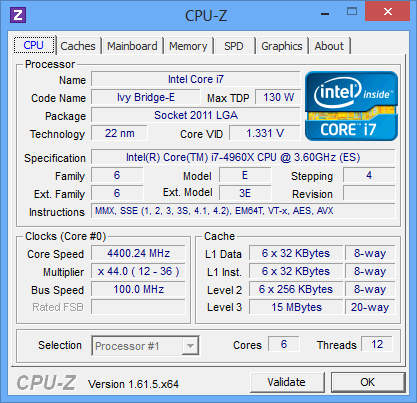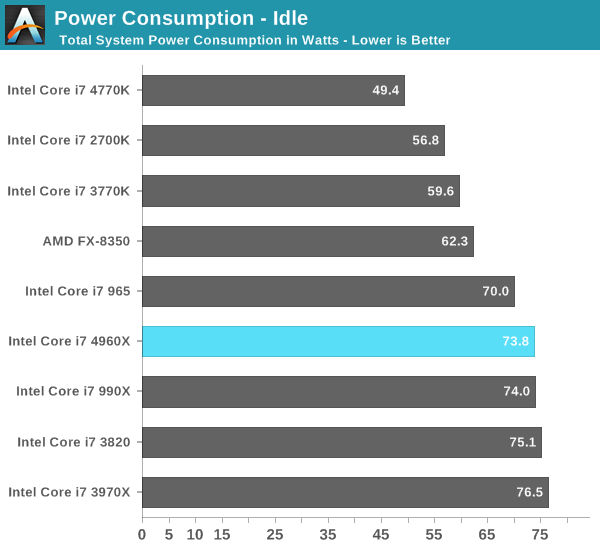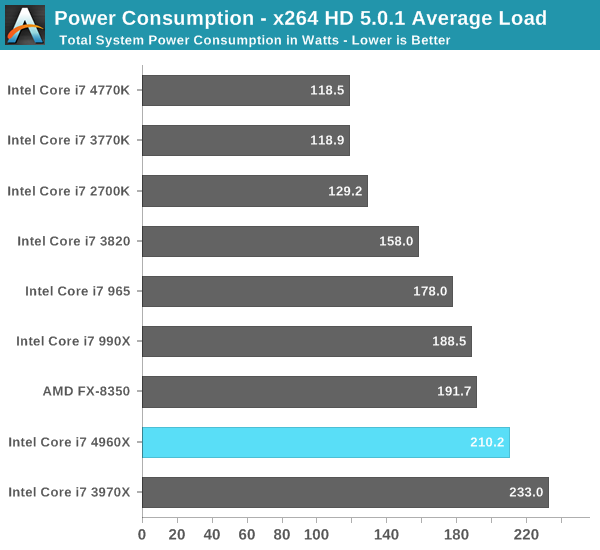Intel Core i7 4960X (Ivy Bridge E) Review
by Anand Lal Shimpi on September 3, 2013 4:10 AM EST- Posted in
- CPUs
- Intel
- Ivy Bridge
- Ivy Bridge-E
Overclocking
As I mentioned earlier, all of the IVB-E launch SKUs ship fully unlocked. Intel offers multipliers up to 63x for you to choose from when overclocking. Like SNB-E before it, IVB-E supports specific BCLK straps (125MHz and 166MHz, in addition to 100MHz) for those overclockers looking to get the absolute most out of their chip. At these overclocked BCLK frequencies, PCIe and other buses are properly divided down so they aren't overclocked (although if you increase the BCLK frequency beyond these strap defaults you will once again be overclocking other buses that derive their frequencies from BCLK). In practice, the cleanest/simplest way to overclock any K-series SKU is by increasing the multiplier.

In our review of the Core i7-3960X I managed a maximum stable overclock of 4.6GHz. I've been told to expect a similar average for Ivy Bridge E. Using Intel's RTS2011LC self contained/closed loop liquid cooling solution I could get into Windows 8 as high as 4.6GHz at 1.42V, however my testbed wasn't stable through all of my tests at that frequency/voltage combination. Moving to higher voltages didn't help, so I had to back down on frequency. I ultimately ended up perfectly stable at 4.3GHz, with 4.4 - 4.5GHz possible with better cooling. The added power needed to hit these frequencies was substantial. I measured a 58W increase in average load power consumption at 4.3GHz/1.4V.

From what I've seen, my sample is a bit on the disappointing side in terms of overclockability. Either way, it doesn't look like you're going to be seeing overclocks significantly higher than what was possible with SNB-E.
Power Consumption
With the 4960X delivering around 5% better performance than the 3970X, the only remaining question is how much more power efficient the move to 22nm made things. Using the same ASUS X79 Deluxe board for both parts, I was able to answer that question.
At idle there's hardly any difference between SNB-E and IVB-E. Under load it looks like IVB-E is good for around a 20W reduction in total system power. It's not an insignificant savings, but definitely not enough to warrant an upgrade if you're on SNB-E already. Anyone looking to migrate to LGA-2011 for the first time will want to go with IVB-E as it is the more thermally efficient solution.












120 Comments
View All Comments
cactusdog - Tuesday, September 3, 2013 - link
IB-E is a massive failure just like SB-E. Thanks Intel for killing the highend for me. Actually, I think this is their plan, to kill the highend. Its ridiculous that this platform is so far behind the mainstream platform. 2x sata 6GB/s ports? No Intel USB 3.0? Worse Single threaded performance than mainstream? Sandy Bridge-e seemed like an unfinished project where many compromises were made and ivy-e looks the same.knweiss - Tuesday, September 3, 2013 - link
Anand, you write that Corsair supplied 4x 8GB DDR3-1866 Vengeance Pro memory for the testbed. However, you also remark "infrequent instability at stock voltages" with 32 GB. Then, in the legend of memory latency chart, you write "Core i7-4960X (DDR3-1600)" .So I wonder which memory configuration was actually used during the benchmarks? Less than 32 GB with DDR3-1866, non-stock voltages, or 32GB DDR3-1600? Wouldn't anything but 4x DDR3-1866 be a little bit unfair because you otherwise don't utilise the full potential of the CPU?
bobbozzo - Tuesday, September 3, 2013 - link
The article says that 1600 is the max memory speed SUPPORTED if you use more than one DIMM per channel.knweiss - Wednesday, September 4, 2013 - link
There are 4 channels.chizow - Tuesday, September 3, 2013 - link
Nice job Anand, your conclusion pretty much nailed it as to why LGA2011 doesn't cut it today and why this release is pretty ho-hum in general. I would've liked to have seen some 4820K results in there to better illustrate the difference between 4770K Haswell and SB-E, but I suppose that is limited by what review samples you received.But yeah, unless you need the 2 extra cores or need double DIMM capacity, there's not much reason to go LGA2011/IVB-E over Haswell at this point. Even the PCIe lane benefit is hit or miss for Nvidia users, as PCIe 3.0 is not officially supported for Nvidia cards and their reg hack is hit or miss on some boards still.
The downsides of LGA2011 vs LGA1150 are much greater, imo, as you lose 4 extra SATA3(6G) ports and native USB 3.0 as you covered, along with much lower overall platform power consumption. The SATA3 situation is probably the worst though, as 2 isn't really enough to do much, but 6 opens up the possibility of an SSD boot drive along with a few really fast SATA3 RAID0 arrays.
TEAMSWITCHER - Tuesday, September 3, 2013 - link
I'm really disappointed by these numbers. As a software developer, the FireFox compile benchmark best indicates the benefit I would get from upgrading to this CPU. And, it looks like the 4770K would be about the same difference - except far less expensive. I really don't think I need anything more than 16GB for RAM, and one high-end graphics card is enough to drive my single WQHD (2560x1440) display. Do bragging rights count? No...I mean really?madmilk - Tuesday, September 3, 2013 - link
Time to consider Xeons...MrBungle123 - Tuesday, September 3, 2013 - link
What's a Xeon going to do? Be slower than the 4960X? You lose clock speed by going with huge core counts and that translates to even more losses in single threaded performance. There comes a point where there are diminishing returns on adding more cores... (see AMD)MrSpadge - Tuesday, September 3, 2013 - link
Time to save yourself some money with a 4770 - not the worst news.Kevin G - Wednesday, September 4, 2013 - link
Your best bet would be to hope for desktop CrystalWell part. That extra cache should do wonders for compile times even if you'd lose a bit of clock speed. However, Intel is intentionally holding back the best socket 1150 parts they could offer as the benefits of Crystalwell + TSX optimized software would put performance into large core count Xeon territory in some cases.